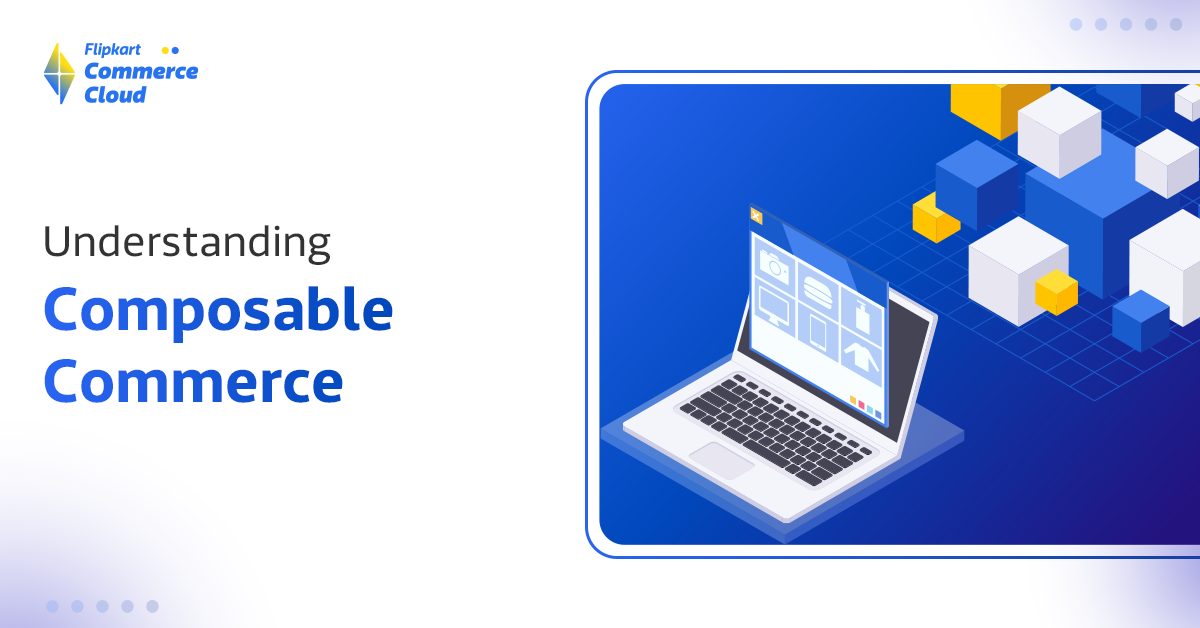
What Is Composable Commerce And Why Is It Important?
By Flipkart Commerce Cloud
Share On:
According to Gartner, businesses adopting a composable approach are set to outpace their competition by over 80% in terms of feature implementation speed. Composable commerce empowers businesses with the flexibility to assemble a unique blend of best-of-breed solutions tailored to specific business needs.
We couldn’t agree more with David Groombridge’s observations when he said that composable business principles are the cornerstone of resilience and growth in today’s volatile market. In an era of soaring customer expectations and digital disruption, traditional commerce platforms are simply unable to keep pace.
For retailers navigating the complexities of e-commerce, the shift to a composable architecture is imperative. It’s no longer about merely establishing an online presence; it’s about crafting a seamless, personalized, and engaging customer experience across multiple touchpoints. Composable commerce provides the foundation for building such experiences, empowering retailers to deliver exceptional value and cultivate lasting customer loyalty.
What is Composable Commerce?
Composable commerce is a modular development approach that allows e-commerce businesses to choose the components they need to build a robust solution and create exceptional commerce experiences. Instead of restricting to a singular technology, it describes a commerce architecture built on modern technologies like JAMstack (JavaScript, APIs, and Markup), cloud-based architecture like microservices, API, cloud, headless, and advanced extensibility frameworks.
At the core of composable commerce is the idea that retail companies are best served by curating a collection of microservices, each addressing a unique business function and need (e.g., searches, checkout and cart, CRM, etc.), rather than having one vendor that provides all of these functions. Its core ethos is about giving brands the control to select the best tools for their needs.
Composable commerce helps you create a fully modular platform where every component is self-contained and can be implemented independently. It enables you to deliver personalized customer experiences, quickly adapt to market changes and integrate new technologies to enhance the user experience.
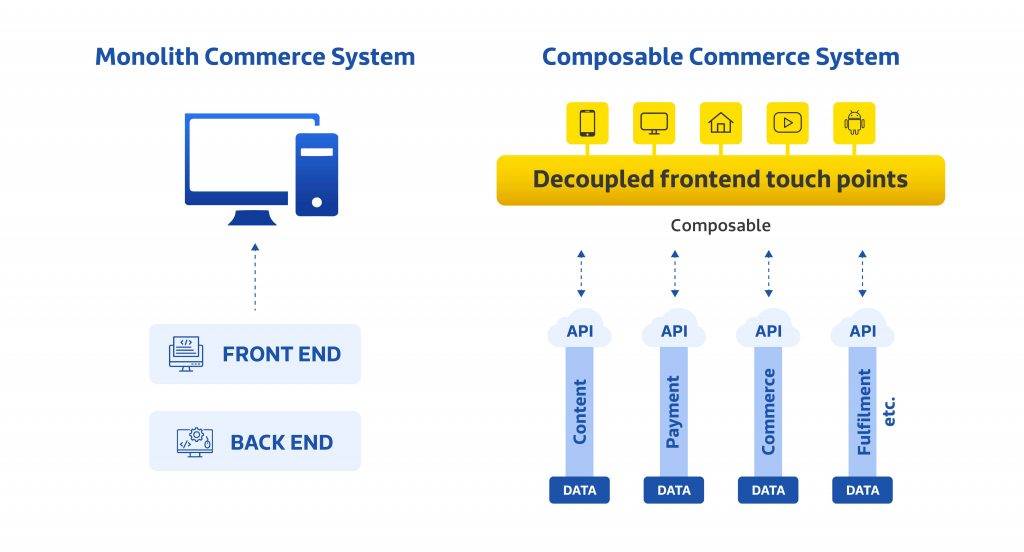
This method marks a shift from the traditional monolithic platforms, which are slow to update and inflexible due to their inability to upgrade frontend and backend separately. With composable commerce, you are not bound by a one-size-fits-all solution. Instead, you have the freedom to compose a tailor-made shopping experience that aligns with your unique needs.
“With monolith structure, what happens is you struggle to keep up with the changing demands for new frontend experiences that is a requirement for today’s modern retail businesses. Whereas composable commerce allows you to make easy, incremental changes without huge investment or expensive developer support.”
A truly composable solution combines three core traits: it has a modular architecture, offers API synergy, and supports cloud scalability. By seamlessly combining these three core traits, composable commerce lets you efficiently drive customer engagement and adapt to dynamic business needs.
- Microservice Architecture: Composable commerce architecture features microservice components that can be easily swapped, replaced, or upgraded, offering plug-and-play flexibility. For example, if you want to offer AI-powered searches on your e-commerce website. You can do this without a complete system overhaul. These components, also known as packaged business capabilities or PBCs, communicate via an API-first approach.
- API Synergy: This approach ensures that each component is exposed through an API, making it possible for services to communicate with each other, even when they are built by different vendors. This gives retailers the flexibility to add or replace components as needed instead of paying for a full suite of software.
- Cloud Scalability: Composable solutions are cloud-native in nature, meaning that the entire software is built on a cloud-based platform. This provides greater scalability, reliability, and flexibility while eliminating the need to maintain in-house servers.
Microservices are gaining popularity
Legacy or monolithic platforms are rigid blocks of software that offer limited customization features and are slow to update. Even though it might be a preferred choice for startups due to faster development, the code and architecture become too complex to tackle as the business scales. For every change and update, the system must be retested and redeployed, which may cause issues and system crashes, making the site unresponsive. This is a direct revenue loss for businesses.
As per McKinsey Next Commerce Study, Gartner 75% of e-commerce retailers experience negative EBIT growth because they are unable to build platforms that enable omnichannel scale and continuous performance optimization on legacy software.
That said, microservice architecture and composable commerce are gaining traction as they offer the flexibility and agility to change the platform without disturbing the backend or compromising on customer experience. Brands like Best Buy, Coca Cola and eBay implemented microservice architecture to adapt to the growing need for faster service and personalization.
During its peak in 2010, when BestBuy was number 10 on the Retailer Top 500, the company realized that making simple changes and updates to its software was becoming extremely difficult. Due to monolithic architecture, they could not prepare for the peak of holiday traffic; this was when their development team decided to use the Strangler Pattern to replace traditional monolithic architecture with microservices.
Benefits of Composable Commerce
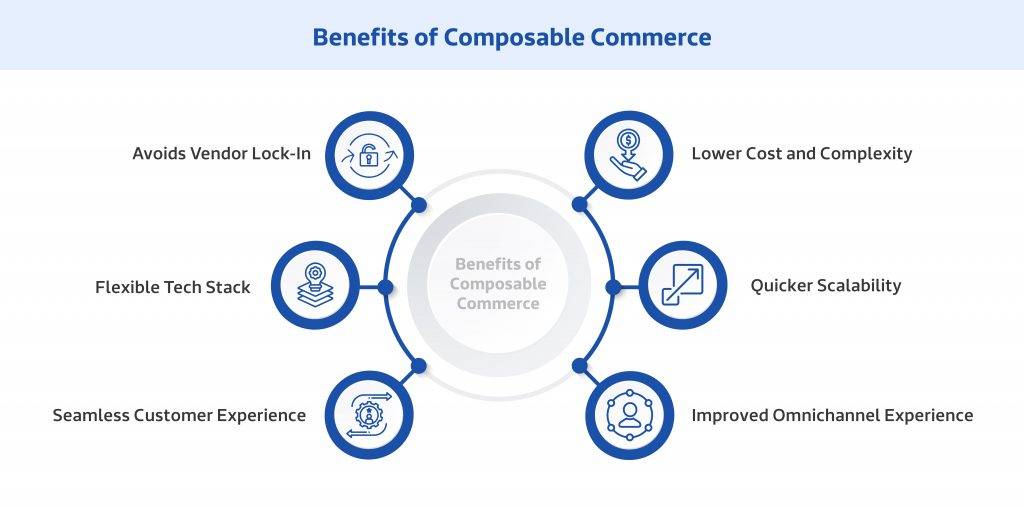
With composable commerce, e-commerce businesses:
- Avoid Vendor Lock-In: Composable commerce reduces dependency on a single vendor, providing the flexibility to choose. For example, you can choose an AI-powered search and discovery platform from one vendor and combine it with personalization software from another. This enables strategic technology decisions, reduces risks, and prevents you from being tied to the limitations of a single vendor’s capabilities.
- Build Flexible Tech Stack: Composable commerce promotes innovation and efficiency by enabling you to leverage the best tools in the market without the need to overhaul the system. When a feature is no longer needed or does not work, you can easily replace it with a better alternative. This gives you the freedom to create a tech stack uniquely suited to your needs.
For example, FCC’s composable commerce solution allows businesses to assemble their commerce tech stack using modular, plug-and-play tools without the dependency on developers and tech teams. This means you can choose the solution as per your requirement, such as cart and checkout, e-commerce search, catalog management, customer relationship management, etc. Even though these solutions are independent, they can seamlessly integrate and communicate with the strategic use of APIs, creating a cohesive and highly customizable e-commerce ecosystem.
Composable commerce gives you better control over customization than a traditional monolithic architecture.
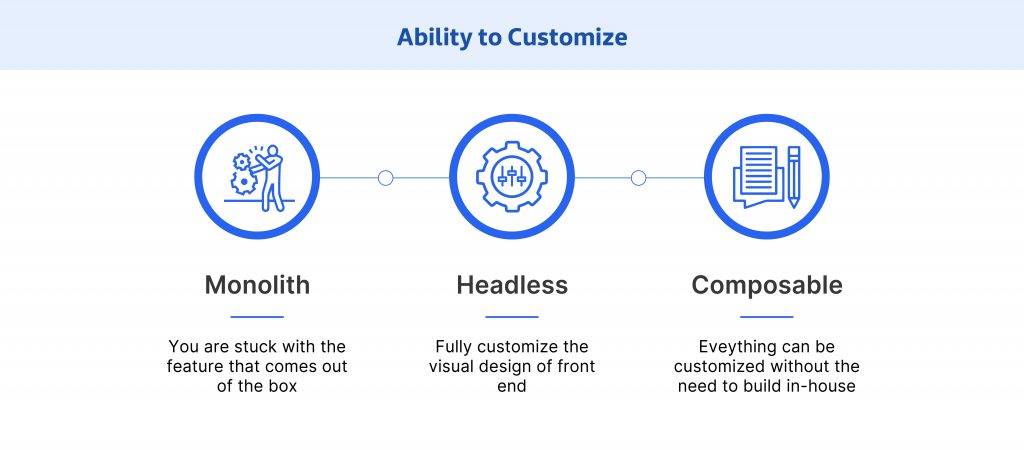
- Achieve Quicker Scalability: Composable commerce can easily scale with growing business demands. As the solution is built on cloud architecture, you don’t have to worry about maintaining servers or handling capacity increases. The ease of customization allows for faster time-to-market while ensuring your platform can handle increased traffic and transaction volumes without compromising performance.
- Provide Seamless Customer Experience: A modular approach enhances the overall customer journey by providing consistent, personalized experiences across all touchpoints. This improves customer satisfaction by ensuring a smooth and engaging shopping experience, regardless of the customer’s preferred touchpoint.
- Lower Cost and Complexity: Composable commerce reduces the total cost of ownership by eliminating unnecessary system-wide upgrades and maintenance. This promotes lean operations and simplifies commerce architecture by enabling businesses to update or replace individual components without disrupting the entire system.
- Improve Omnichannel Experience: Composable commerce improves the omnichannel experience by providing a unified and consistent brand experience across online and offline touchpoints. It enables you to adapt and refine your digital commerce strategies readily, ensuring a seamless shopping experience for customers across all channels.
How does Composable Commerce Enable a Unified Commerce Experience?
As per Harvard Business Review, omnichannel customers spend on average 4% more on every shopping experience and 10% more on online channels than single-channel customers.
Today, the consumer demands a seamless shopping experience across all touchpoints. They want to instantly find, browse, and buy products irrespective of whether they are buying on a marketplace, e-commerce website, in-store or on a social app.
This is where unified commerce comes into picture, as it combines all sales channels and customer touchpoints into a single, seamless customer experience. The goal is to provide a consistent and personalized shopping experience, whether online or offline.
Composable commerce plays a crucial role in facilitating unified commerce by becoming a single source of truth for your data from various sources like Customer Relationship Management (CRM), Content Management Systems (CMS), Product Information Management (PIM), etc. This helps create a comprehensive customer profile with consistent real-time data.
At FCC, we define these as cohesive commerce ecosystems, where e-commerce services work together and focus on delivering exceptional customer experiences by leveraging data, machine learning, and a deep understanding of customer behavior.
For instance, a customer might start their shopping journey online, browsing products on your website. Later, they might visit your physical store to try out the product before making a purchase. With a composable commerce platform, the customer’s online browsing history can be seamlessly integrated with their in-store experience. For example, the platform can analyze the customer’s past purchases, browsing behavior and social media interactions to suggest highly personalized product recommendations.
How to Choose the Right Composable Commerce Platform?
Selecting the right composable commerce system is an important choice that can significantly impact your e-commerce business.
To ensure you choose the best platform for your business, carefully evaluate potential composable commerce vendors based on the following factors:
- Verify that the platform is built on a foundation of APIs, enabling seamless integration with other systems and services. Inquire about the extent of API coverage, including whether REST and GraphQL APIs are supported.
- Prioritize platforms built on cloud-native technology, as they offer scalability, flexibility, and the ability to adapt to changing business needs.
- Understand the complexity and timeline of the migration process. Inquire about the level of support provided during migration and deployment to ensure a smooth transition.
- Evaluate the platform’s ability to integrate with your existing systems, such as ERP, CRM, and marketing automation platforms. A robust integration framework is essential for a unified commerce experience.
- Consider the platform’s ability to handle increased traffic and growth. Evaluate uptime and choose platforms that prioritize data security and compliance with industry standards.
- Evaluate the total cost of ownership, including licensing fees, implementation costs, and ongoing maintenance expenses.
- Assess the vendor’s reputation, customer support, and track record of successful implementations.
- Evaluate the platform’s ability to accelerate your time-to-market for new products, features, and campaigns.
- Assess the platform’s data management capabilities and the insights it can provide to optimize your business operations.
These factors form a quick RFP (Request for Proposal) checklist that you can use when evaluating different composable commerce platforms.
Experience Composable Commerce with Flipkart Commerce Cloud
With Flipkart Commerce Cloud, you can set up an end-to-end digital commerce engine on the cloud tailored to your specific growth goals.
Where building an enterprise-grade digital commerce engine can take 8+ months and tens of thousands of dollars — with zero guarantees of success. Our versatile composable digital retail solutions, perfected over 15+ years, give you a much quicker time to value without draining your entire tech budget.
We offer comprehensive solutions for your e-commerce requirements:
- Customer Buying Portal: Our platform is supported by composable architecture, offering tools like storefronts and page constructs for creating dynamic content, personalization and recommendation modules for granular search and browsing capabilities. We also provide features like rich media catalog management, cart-and-checkout, intelligent reviews, and AI-driven CRM with chatbot integration that help you prioritize your customers, delivering an exceptional digital shopping experience.
- Seller Management Module: Equip your sellers with an intuitive dashboard that simplifies the management of product listings, inventory, orders, and finances. Our platform streamlines seller onboarding, offers real-time order tracking, and efficiently handles commission management, fostering a vibrant marketplace environment.
- Supply Chain Management: This module incorporates an Order Management System, Warehouse Management System, and 3PL Handling Systems, all aimed at optimizing your supply chain. These tools support timely deliveries by providing real-time tracking and efficient route planning, ultimately boosting customer satisfaction.
That is not all. In addition to the digital commerce engine, we provide advanced business modules designed for revenue growth and profit maximization. These include:
- Retail Media: With FCC’s Ads Manager, deliver a self-serve advertising portal to partner brands, run dynamic display, contextual, and listing ads at scale, accurately evaluate full-funnel ads performance, and track KPIs and automate reporting for sellers via native dashboards.
- Pricing Manager Module: Implement advanced pricing strategies using our intelligent pricing algorithms. These algorithms consider factors such as competitive pricing, demand elasticity, and market trends. Our Pricing Platform is designed for ease of use and maximum impact to deliver a revenue increase of 3-5% and a margin enhancement of 4 to 7%. It also saves you time on repricing tasks and ensures 100% accurate pricing with human-in-loop interventions.
Interested to know more about FCC’s offering? Get in touch with our experts today.
More Blogs
See how retailers and brands are winning with FCC

Everything About Price Skimming Strategy Explained
Read More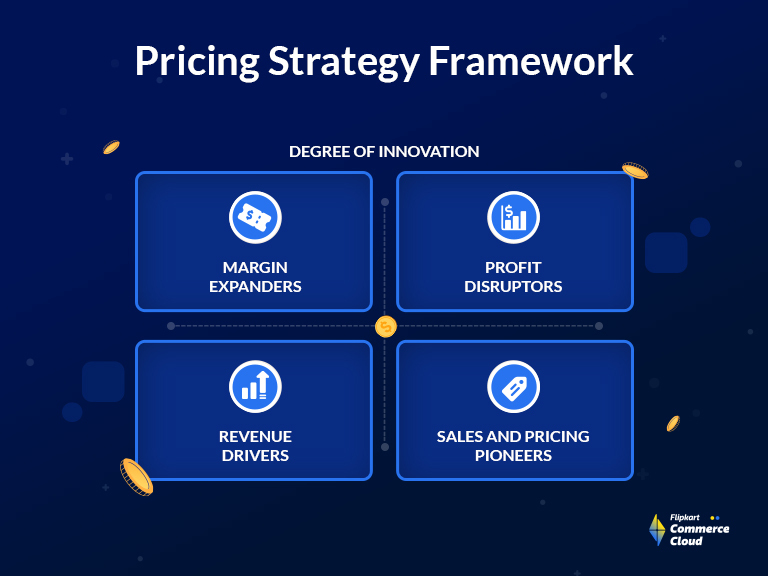
Mastering Pricing Strategy Framework
Read More
What is a High-Low Pricing Strategy?
Read More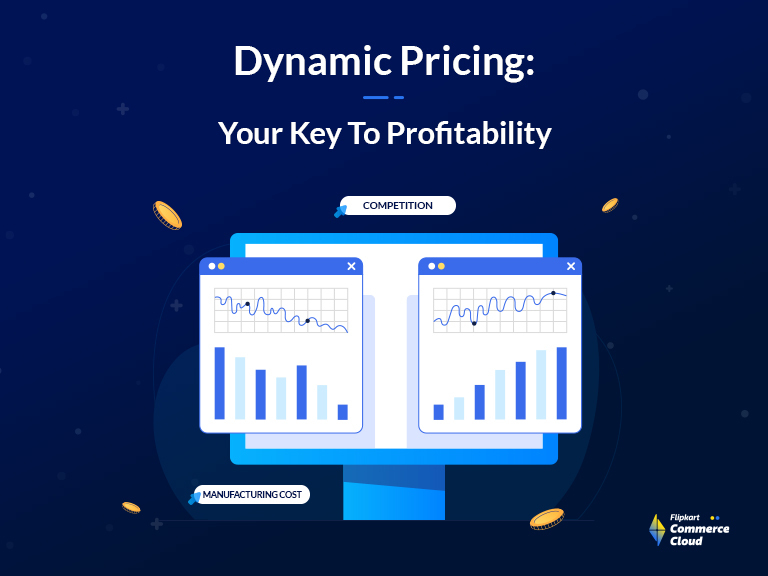
Ultimate Guide To Dynamic Pricing Strategy In 2025
Read More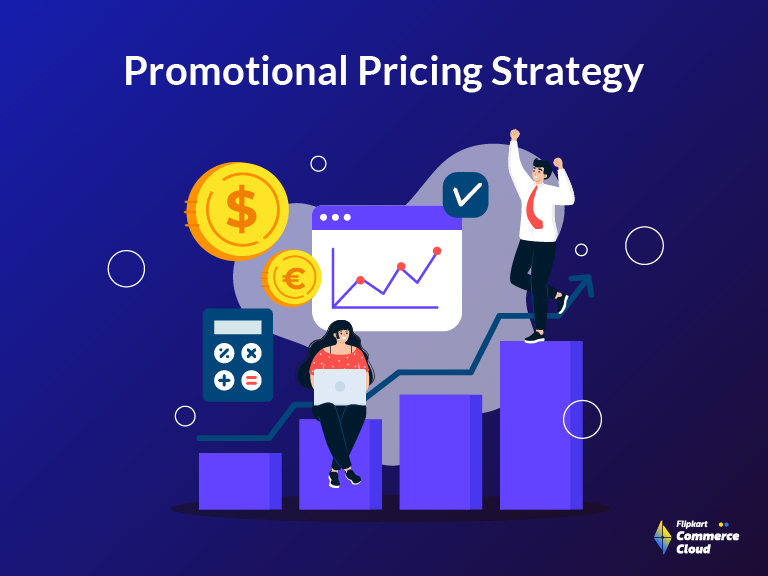
Retail Pricing Strategies: Winning with Promotion Pricing in Competitive Markets
Read MoreTerms and Conditions
Flipkart is committed to protecting and respecting your privacy, and we’ll only use your personal information to administer your account and to provide the products and services you requested from us. From time to time, we would like to contact you about our products and services, as well as other content that may be of interest to you. If you consent to us contacting you for this purpose, please tick below to say how you would like us to contact you:
You can unsubscribe from these communications at any time. For more information on how to unsubscribe, our privacy practices, and how we are committed to protecting and respecting your privacy, please review our Privacy Policy.
By clicking submit below, you consent to allow Flipkart to store and process the personal information submitted above to provide you the content requested.
